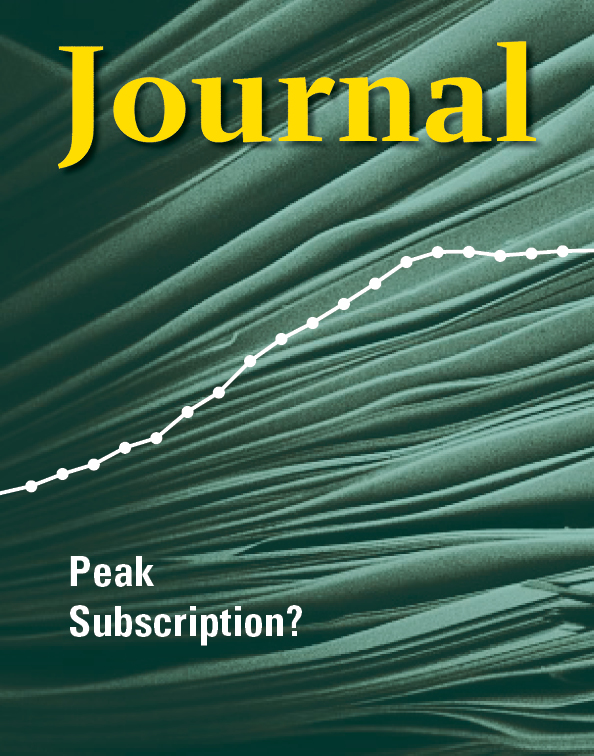
Editor’s Note: Next week I’m speaking at the North American Conference for the International Society of Managing and Technical Editors. One of the talks I’m giving is a general industry roundup, and in putting it together, this 2014 post from Michael Clarke continues to resonate, as it explains the main economic driving forces in scholarly publishing. The business conditions explained here explain the wave of mergers and acquisitions, the wave of startups and new ventures from existing companies and the drive toward open access from many publishers.
As the season turns to autumn I find myself looking back over what seems a long summer of bustle and enterprise, fueled by the energy of long days and luxuriously temperate weather. This summer also witnessed a commotion of travel, with holidays, client visits, and a whirlwind tour of professional conferences.
In sitting down to organize the jumble of notes from the many conferences, one phrase stuck out. At the 36th Annual Meeting of the Society for Scholarly Publishing, I moderated a session with Jan Velterop (CEO of Academic Concept Knowledge), Toby Green (Head of Publishing at OECD), and Susan Hezlet (Publisher of the London Mathematical Society) on using “freemium” business models as an alternative to the common “author-pays” (or Gold OA) model for open access publishing.
During this session, Jan Velterop used the term “peak subscription” (as in “peak oil”) to describe the current market context for STM and scholarly journal publishing. The phrase neatly captures what is arguably the most important trend – a sea change – in STM and scholarly publishing today.
Since the late 1990s there have been two drivers of growth in STM and scholarly publishing:
- Site Licensing – Including converting institutional subscriptions to site licenses, optimizing pricing tiers, and rolling up content assets into the “Big Deal” and other packages.
- Global Expansion – Selling the aforementioned site licenses to institutions throughout the world, expanding into regions such as China, India, Eastern Europe, the Middle East, and South America where STM and scholarly publishers, most of whom are based in North America and Western Europe, have heretofore had limited customer bases.
These activities have proven successful for publishers, driving growth (in some cases, double-digit growth) for nearly two decades. These activities have been good for institutions and their faculty and students as well, providing more people access to more content than ever before at ever-diminishing costs (when measured on a cost per use basis).
As successful as these activities have been, however, we appear to be nearing, if not a peak, at least a plateau. While per-use costs have decreased, absolute prices have increased. This increase is due to the ever-increasing volume of content being published. Institutional library budgets have not, however, kept pace with the growth in global research output. The institutional marketplace is perhaps becoming, as Joe Esposito argues, a zero-sum game.
At the same time, institutional market penetration is nearing saturation for many publishers. There are only so many institutions in the world to sell site licenses to, and the sales forces that publishers have built (or contracted with) have been effective. Yes, there will be some additional growth in emerging markets, but nothing like the global expansion in licensing that occurred over the last fifteen years.
This does not mean that the site license or the Big Deal is going anywhere – the benefits for all parties remain too great. The Big Deal will continue to be renewed, providing libraries with large volumes of content and (some) publishers with incremental revenue growth. The key word here being incremental. We have reached the point where site licensing is likely to cease being an engine of significant growth for most publishers.
So the question is, where is the growth going to come from?
In surveying the publishing landscape, publishers appear to be pursuing three growth strategies:
- Growing Market Share. With library budgets lagging research output and the global marketplace nearing saturation, increasing your revenues increasingly means taking revenues away from someone else. In this zero-sum landscape, the stakes are raised ever higher for the Big Deal. The biggest of the Big Deals captures the largest slice of revenue. Publishers offering such deals will continue to add content, especially must-have society titles. Along with society additions, publishers will continue to develop new “daughter” titles associated with their own premium brands and will increase their use of cascading peer review strategies to flow papers to these titles.
- Developing New Revenue Streams. The most notable new revenue stream is, of course, the article-processing charges (APCs) associated with Gold OA titles. APCs often come from sources other than the library, including other areas of the institution as well as research funders. Gold OA allows publishers to continue to grow a product category in which they have existing economies of scale (e.g. composition, workflow systems, platform hosting), while at the same time opening up revenues from new sources.
- New Product Development. By this I mean development of new product categories beyond journals and books. Most prominent here are digital workflow and data products as such products are often licensed using institutional budgets outside the library. Additionally, publishers can often make compelling business cases for licensing workflow and data products that either boost productivity or improve work quality (or ideally, both). Examples of such products, which often combine software and content, include clinical decision support tools (McGraw-Hill’s ClinicalAccess, Wolters Kluwer’s UptoDate, American College of Physicians’ Smart Medicine), document sharing tools (Colwiz, Elsevier’s Mendeley), analytics tools (Elsevier’s SciVal, JBJS’s SocialCite and PRE-val, Digital Science’s Altmetric), board review and maintenance of certification products (McGraw-Hill’s USMLE Easy, American Academy of Pediatrics’ PREP, American College of Chest Physicians’ SEEK), and many others.
The first strategy – growing market share – is a defensive one that any publisher with a strong market position must attend to. The vast majority of revenues in the STM and scholarly publishing industry are derived from subscription products – products and revenues that are not going away and, in fact, are likely to continue to grow at a modest clip. But revenue gains are likely to be unevenly distributed and advantages lie with those organizations with the largest portfolios and/or “must-have” brands.
The second strategy – developing new revenue streams – is (to use management consultant speak) a “no brainer.” Gold OA means new revenue sources without having to incur the risk of entering a new product category. Publishers can continue to leverage the economies of scale, workflows, technologies, and talent they have developed in publishing subscription products, bringing these to bear for Gold OA titles. This is essentially a product-extension strategy, employing existing capabilities and delivery systems to capture new revenues with relatively modest levels of investment.
It is important to note, however, that revenues from APCs are miniscule, accounting, according to Outsell, for approximately 1% of STM industry revenues or just over 2% of the journals market excluding society memberships (see Outsell’s Open Access: Market Size, Share, Forecast, and Trends report, which you can download free here courtesy of the Copyright Clearance Center). This figure should serve as a caution for those who assume APCs will replace or match subscription revenues in the foreseeable future. It also underscores how nascent open access publication models remain, with long-term funding for APCs uncertain. That said, the growth rate for Gold OA is much higher than that of subscription products (albeit starting from a much lower base). Outsell projects open access revenues to grow at a CAGR of 27% from 2012 to 2015 across the industry. Growth rates for subscription products are meanwhile hovering in the mid-to-low single digits. Given the low level of investment required, the ability to capture revenues from new sources, and the growth rate, this strategy is increasingly being viewed as an opportunity for many organizations.
The third strategy – new product development – is more complex, costly, and in many ways more risky, but the rewards are also potentially greatest. Successful workflow and data products can generate high margins, create deeper engagement with users, and often boast high rates of renewal. It is also difficult to compete with organizations with entrenched workflow or data products as such products are often integrated into other systems and processes. This strategy, however, requires making relatively substantial investments in products that may or may not prove successful. Such products may not be able to leverage any existing economies of scale and may require new approaches to marketing and new sales channels. Further, the techniques and skills required to be successful in forging new (to the organization if not the market) product categories are often different than those employed in product line extensions. Because of these complexities publishers are creating entirely new “innovation centers” focused on such products, the most prominent being Macmillan’s Digital Science.
These strategies are not mutually exclusive and in fact most publishers, large or small, will want to consider all three. Larger publishers, of course, have an advantage with regard to growing market share and they bring economies of scale to Gold OA publishing. But they do not hold all the cards with regard to OA publishing. Open access publishing is a competition for authors, and society publishers are often closer to their member authors than a commercial house might be. This area of the market (Gold OA) remains so nascent that it is too soon to tell which organizations and organizational strengths will result in long-term competitive advantage.
And while commercial publishers can often make larger investments in R&D related to the development of digital workflow and data products than society publishers, this should not dissuade society publishers from pursuing this strategy (and I say “often” not “always” as there are many examples of professional associations sitting on substantial reserves that can used to fund such investments). There are examples of successful workflow and data products from professional societies, who are in an excellent position to anticipate the workflow needs of their members. Being smaller can, in some cases, have advantages.
Each organization will need to assess their existing portfolios and determine the most appropriate path forward with regard to each of the above strategies. In some cases, product lines can even shift between strategies. Nature Communications, for example, was originally launched as a hybrid OA/subscription product in support of a market share growth strategy. Just last week, however, Nature Publishing Group announced it was shifting the publication (which has been successful in commanding relatively high APCs) to a Gold OA model supporting a new revenue sources strategy.
While there are certain to be examples of organizations that focus successfully on only one of these strategies, most publishing concerns will pursue diversification and the hedging of risk that comes with it. Managing the product pipeline and the level of investment associated with each of these strategies will be the great challenge of organizational leadership in the coming decade.
Note: Thanks to PH for thoughtful comments and edits and YF for graphics support.
Discussion
4 Thoughts on "Revisiting: Peak Subscription"
Michael interesting article, however you fail to mention acquisition of companies and the pursuit of society and association journals. In short, one can grow organically which you describe or by acquisition which you do not.
Interesting article. New revenue streams and new product development are key moving forward. Whomever a scholarly content “consumer” is, their needs have moved way beyond the ability to subscribe and publish. I think that moving forward the industry will be creating and embracing the use of embedded tools and toolsets for content creation and marketing, tools which encourage “career management” for researchers in terms of where they publish and what they publish, and no-one in the industry can be unaware of the opportunity that exists within portals and niche networks.



